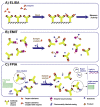Novel technologies in detection, treatment and prevention of substance use disorders
- PMID: 30648574
- PMCID: PMC9298618
- DOI: 10.1016/j.jfda.2018.09.003
Novel technologies in detection, treatment and prevention of substance use disorders
Abstract
Substance use disorders are a widely recognized problem, which affects various levels of communities and influenced the world socioeconomically. Its source is deeply embedded in the global population. In order to fight against such an adversary, governments have spared no efforts in implementing substance abuse treatment centers and funding research to develop treatments and prevention procedures. In this review, we will discuss the use of immunological-based treatments and detection kit technologies. We will be detailing the steps followed to produce performant antibodies (antigens, carriers, and adjuvants) focusing on cocaine and methamphetamine as examples. Furthermore, part of this review is dedicated to substance use detection. Owing to novel technologies such as bio-functional polymeric surfaces and biosensors manufacturing, detection has become a more convenient method with the fast and on-site developed devices. Commercially available devices are able to test substance use disorders in urine, saliva, hair, and sweat. This improvement has had a tremendous impact on the prevention of driving under influence and other illicit behaviors. Lastly, substance abuse became a major issue involving the cooperation of experts on all levels to devise better treatment programs and prevent abuse-based accidents, injury and death.
Keywords: Biosensors; Cocaine/methamphetamine; Drug detection; Immunotherapy; Substance use disorder.
Copyright © 2018. Published by Elsevier Taiwan LLC.
Figures



Similar articles
-
An overview of the use of urine, hair, sweat and saliva to detect drug use.Drug Alcohol Rev. 2004 Jun;23(2):213-7. doi: 10.1080/09595230410001704208. Drug Alcohol Rev. 2004. PMID: 15370028
-
Trends in analyzing emerging drugs of abuse--from seized samples to body samples.Anal Bioanal Chem. 2014 Oct;406(25):6105-10. doi: 10.1007/s00216-014-8082-3. Epub 2014 Aug 17. Anal Bioanal Chem. 2014. PMID: 25129635 Review.
-
On-site testing of saliva and sweat with Drugwipe and determination of concentrations of drugs of abuse in saliva, plasma and urine of suspected users.Int J Legal Med. 2000;113(3):150-4. doi: 10.1007/s004140050287. Int J Legal Med. 2000. PMID: 10876986
-
Rapid and sensitive detection of drugs of abuse in sweat by multiplexed capillary based immuno-biosensors.Analyst. 2020 Feb 17;145(4):1346-1354. doi: 10.1039/c9an02498k. Analyst. 2020. PMID: 31967116
-
A review of drug abuse in recently reported cases of driving under the influence of drugs (DUID) in Asia, USA, and Europe.Forensic Sci Int. 2019 Sep;302:109854. doi: 10.1016/j.forsciint.2019.06.012. Epub 2019 Jun 14. Forensic Sci Int. 2019. PMID: 31255839 Review.
Cited by
-
Unveiling the Complexities of Medications, Substance Abuse, and Plants for Recreational and Narcotic Purposes: An In-Depth Analysis.Pharmacy (Basel). 2025 Jan 22;13(1):7. doi: 10.3390/pharmacy13010007. Pharmacy (Basel). 2025. PMID: 39998006 Free PMC article. Review.
-
Inhibition of CSF1R, a receptor involved in microglia viability, alters behavioral and molecular changes induced by cocaine.Sci Rep. 2021 Aug 6;11(1):15989. doi: 10.1038/s41598-021-95059-7. Sci Rep. 2021. PMID: 34362959 Free PMC article.
References
-
- Degenhardt L, Whiteford HA, Ferrari AJ, Baxter AJ, Charlson FJ, Hall WD, et al. Global burden of disease attributable to illicit drug use and dependence: findings from the Global Burden of Disease Study 2010. Lancet. 2013;382(9904):1564–74. - PubMed
-
- Martell BA, Mitchell E, Poling J, Gonsai K, Kosten TR. Vaccine pharmacotherapy for the treatment of cocaine dependence. Biol Psychiatry. 2005;58(2):158–64. - PubMed
Publication types
MeSH terms
Substances
LinkOut - more resources
Full Text Sources
Medical
